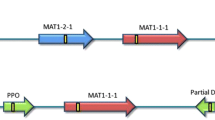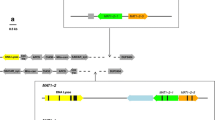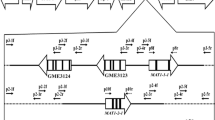Abstract
Cochliobolus lunatus (teleomorph: Curvularia lunata) is an important plant pathogenic fungus that causes the maize foliar spot, resulting in serious yield losses. In ascomycetes, a single mating-type (MAT) locus with two idiomorphs controls sexual development. The structure and arrangement of the MAT genes were examined to understand the MAT locus of C. lunatus. MAT loci were MAT1–1-1 or MAT1–2-1, flanked upstream and downstream by regions encoding GTPase activating protein, pyridoxamine phosphate oxidase domain, and β-glucosidase. A MAT1–1 or MAT1–2 idiomorph was identified in single isolate, and sexual reproduction in vitro indicated that the species was heterothallic. In vitro crossing between isolates with opposite MATs produced perithecia, asci, and ascospores. A multiplex MAT-specific PCR method was developed and used to test mating-type genes in 177 C.lunatus isolates collected from China. The ratio of isolates of each mating-type in China was consistent with a 1:1 ratio.




Similar content being viewed by others
References
Becker, K., Beer, C., Freitag, M., & Kück, U. (2015). Genome-wide identification of target genes of a MAT α-domain transcription factor reveals functions beyond sexual development. Molecular Microbiology, 96(5), 1002–1022.
Böhm, J., Hoff, B., O'Gorman, C. M., Wolfers, S., Klix, V., & Binger, D. (2013). Sexual production and MAT-mediated strain development in the penicillin-producing fungus penicillium chrysogenum. Proceedings of the National Academy of Sciences, 110, 1476–1481.
Brewer, M. T., Cadle-Davidson, L., Cortesi, P., Spanu, P. D., & Milgroom, M. G. (2011). Identification and structure of the MAT locus and development of PCR-based markers for MAT in powdery mildew fungi. Fungal Genetics and Biology, 48, 704–713.
Christiansen, S. K., Wirsel, S., Yun, S. H., Yoder, O. C., & Turgeon, G. B. (1998). The two Cochliobolus MAT genes are conserved among species but one of them is missing in C. victoriae. Mycological Research, 102(8), 919–929.
Coppin, E., Debuchy, R., Arnaise, S., & Picard, M. (1997). MATs and sexual development in filamentous ascomycetes. Microbiology and Molecular Biology Reviews, 61, 411–428.
Dahlmann, T. A., Böhm, J., Becker, K., & Kück, U. (2015). Sexual recombination as a tool for engineering industrial Penicillium chrysogenum strains. Current Genetics, 61(4), 1–5.
Duan, S. K. (1984). Survey on yellow spot of Huangzaosi. Plant Protection, 6, 12.
Gao, S. G., LI, Y. Q., Gao, J. X., Suo, Y. J., Fu, K. H., Li, Y. Y., & Chen, J. (2014). Genome sequence and virulence variation-related transcriptome profiles of Curvularia lunata, an important maize pathogenic fungus. BMC Genomics, 15, 627.
Hastings, I. M. (1992). Population genetic aspects of deleterious cytoplasmic genomes and their effect on the evolution of sexual reproduction. Genetical Research, 59, 215–225.
Lin, X., & Heitman, J. (2007). Mechanisms of homothallism in fungi and transitions between heterothallism and homothallism. Sex in fungi: Molecular Determination and Evolutionary Implications (pp. 283–300).
Lu, G. Z., Chen, J., Bai, J. K., & Wang, C. P. (1997). Occurrence situation and control measures of corn disease in China. Plant Protection, 23(4), 20–21.
Macri, F., & Lenna, P. (1974). Leaf corn blight incited by Curvularia lunata (Wakker) Boed. Journal of Plant Pathology, 10, 27–35.
Nelson, R. R. (1959). Genetics of Cochliobolus heterostrophus. I. Variability in Degree of Compatibility. Mycologia, 51(1), 18–23.
Nelson, R. R., & Haasis, F. A. (1964). The perfect stage of Curvularia lunata. Mycologia, 56(2), 316–317.
O’Gorman, C. M., Fuller, H. T., & Dyer, P. S. (2008). Discovery of a sexual cycle in the opportunistic fungal pathogen Aspergillus fumigatus. Nature, 457, 471–474.
Paoletti, M., Seymour, F. A., Alcocer, M. J. C., Kaur, N., Calvo, A. M., Archer, D. B., & Dyer, P. S. (2007). MAT and the genetic basis of self-fertility in the model fungus Aspergillus nidulans. Current Biology, 17, 1384–1389.
Pearce, T. L., Scott, J. B., Hay, F. S., & Pethybridge, S. J. (2016). MAT gene structure and spatial distribution of Didymella tanaceti in pyrethrum fields. Phytopathology, 106(12), 1521–1529.
Sharon, A., Yamaguchi, K., Christiansen, S., Horwitz, B. A., Yoder, O. C., & Turgeon, B. G. (1996). An asexual fungus has the potential for sexual development. Molecular & General Genetics, 251(1), 60–68.
Turgeon, B. G. (1998). Application of MAT gene technology to problems in fungal biology. Phytopathology, 36, 115–137.
Turgeon, B. G., Bohlmann, H., Ciuffetti, L. M., Christiansen, S. K., & Yang, G. (1993). Cloning and analysis of the MAT genes from Cochliobolus heterostrophus. Molecular & General Genetics, 238, 270–284.
Turgeon, G. B., Sharon, A., Wirsel, S., Christiansen, S. K., Yamaguchi, K., & Yoder, O. C. (1995). Structure and function of mating type genes in Cochliobolus spp. and asexual fungi. Canadian Journal of Botany, 73, S788–S783.
Wang, X. M., Jin, Q. M., Shi, J., Wang, Z. Y., & Li, X. (2006). The status of maize diseases and the possible effect of variety resistance on disease occurrence in the future. Acta Phytopathologica Sinica, 36, 1–11.
Wirsel, S., Horwitz, B., Yamaguchi, K., Yoder, O. C., & Turgeon, B. G. (1998). Single MAT-specific genes and their 3′ UTRs control mating and fertility in Cochliobolus heterostrophus. Molecular & General Genetics, 259, 272–281.
Yun, S. H., Berbee, M. L., Yoder, O. C., & Turgeon, B. G. (1999). Evolution of the fungal self-fertile reproductive life style from self-sterile ancestors. Proceedings of the National Academy of Sciences, 96, 5592–5597.
Zhang, L., Li, H., Xiao, S. Q., Lu, Y. Y., Li, G. F., Xue, C. S., & Chen, J. (2016). Efficient Agrobacterium tumefaciens-mediated target gene disruption in the maize pathogen Curvularia lunata. European Journal of Plant Pathology, 145(1), 155–165.
Zheng, Q., Hou, R., Zhang, J. Y., Ma, J. W., Wu, Z. S., Wang, G. H., Wang, C. F., & Xu, J. R. (2013). The MAT locus genes play different roles in sexual reproduction and pathogenesis in Fusarium graminearum. PLoS One, 8(6), e66980.
Zhong, S., & Steffenson, B. J. (2001). Genetic and molecular characterization of MAT genes in Cochliobolus sativus. Mycologia, 93(5), 852–863.
Acknowledgements
This study was supported by the National Natural Science Foundation of China (Grant number 31271992) and China Agriculture Research System (Grant number CARS-02).
Author information
Authors and Affiliations
Corresponding author
Ethics declarations
I would like to declare on behalf of my co-authors that the work described was original research that has not been published previously, and not under consideration for publication elsewhere, in whole or in part. All the authors listed have approved the manuscript that is enclosed.
Conflict of interest
No conflict of interest exits in the submission of this manuscript, and manuscript is approved by all authors for publication.
Human and animal studies
Research did not involving Human Participants and/or Animals.
Electronic supplementary material
Supplementary Table 1
(DOCX 17 kb)
Supplementary Fig 1
(DOCX 30 kb)
Rights and permissions
About this article
Cite this article
Lu, Y.Y., Liu, K.X., Li, G.F. et al. Identification mating-type locus structure and distribution of Cochliobolus lunatus in China. Eur J Plant Pathol 151, 487–500 (2018). https://doi.org/10.1007/s10658-017-1393-4
Accepted:
Published:
Issue Date:
DOI: https://doi.org/10.1007/s10658-017-1393-4




